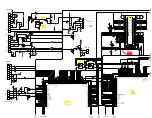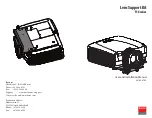
PREPARATION OF THE PORTS
1. Select the correct port:
Depending on whether you’ve decided to shoot macro or wide angle photography, you will be installing either a flat Macro Port (product
# 18426 or 18428), or a Dome Port (Product # 18405, 18407 or 18409).
See lens chart for the suggested port and accessories.
Macro Port Extension Rings:
If you intend to use a longer Macro lens than the Canon EF-S 60mm you will require an additional
extension ring. This extension rings fit between the Macro Port and the housing to provide the extra space necessary for the longer
lens.
See lens chart for the suggested port and accessories.
Dome Port Extension Rings:
When using a wide angle or zoom lens, the Dome Port may require the uses of an extension ring to
closely match the optical center of both the dome and the lens.
See lens chart for the suggested port and accessories.
In order to reduce glare, maximize contrast and offer physical protection to the dome, the use of a dome shade is highly recommended.
See lens chart for the suggested dome shade.
A comprehensive list of the lenses supported and their required extensions and/or accessories is supplied at the end of this manual. For
the latest uptdated version of this lens chart, you can refer to the Lens Chart for the Aquatica 7D housing on
www.aquatica.ca
2. Clean the port:
Dirt, grease or fingerprints on the port especially on the inside, can adversely affect the quality of the image. Acrylic ports should be
cleaned with plastic cleaner and the glass ports should be cleaned with lens cleaner. For more details be sure to read the section titled
“
Care and Maintenance: of the Ports.
”
3. Lubricate the port O-ring seal:
Before using the port, remove the O-ring on the rear of the port and lightly coat it with silicone grease. For more details be sure to read
the section titled “
Care and Maintenance: of the O-rings.
”
PREPARATION OF THE LENS
Depending on the lens used, there are a number of gear options possible. Using the right gear (s) and correctly mounting
them on the lens is very important for a smooth housing operation. Follow the installation directions included with each gears carefully.
The use of EF types lenses is mandatory.
A comprehensive list of the lenses supported and their required gears is supplied at the end of this manual. For the latest uptdated
version of this lens chart, you can refer to the Lens Chart on
www.aquatica.ca
Notes:
If the camera is set in manual focus a focus gear must be mounted on the lens. If you are using a zoom lens with a
zoom ring the camera must be on auto focus, also note that if using a dome port you may need to install a closeup diopter on the
lens to correct the minimum focusing distance of the lens so that it will be able to focus on the virtually projected image created by the
dome.
See lens chart for the suggested diopter, if required for your lens/port combination.
Gear installation:
Mounting the gear over the focus or zoom ring of the lens.
(a) For Slip-on gears (gears without mounting screws): Slide the gear over the lens and align the gear with the front of the lens focusing ring.
(b) For gears with mounting screws:Tighten lightly the three set screws evenly. Tighten each screw approximately ½ a turn working
around the gear until all the three (3) screws are tightened, and the gear is concentric with the lens body.
CAUTION:
Do not over-tighten these screws, as this might bind the lens, thus restricting the rotation of the focus ring and/or damaging
the lens. Conversely under-tightening these screws might cause the gear to slip or loose alignment.
Rotate the focus ring several times to make sure it moves smoothly and the gear does not slip before closing the housing
WARNING:
If the lens is a not of the USM type, never attempt to operate it with the camera in autofocus mode and with a mounted
focus gear engaged. This might cause serious damage to your lens focusing motor.
Zoom lenses:
When using a zoom lens, the gear should be mounted on the zoom lens control. The housing focus control then
becomes
the zoom control. Focusing of lens is achieved by using the camera’s autofocus system.
page 6

































